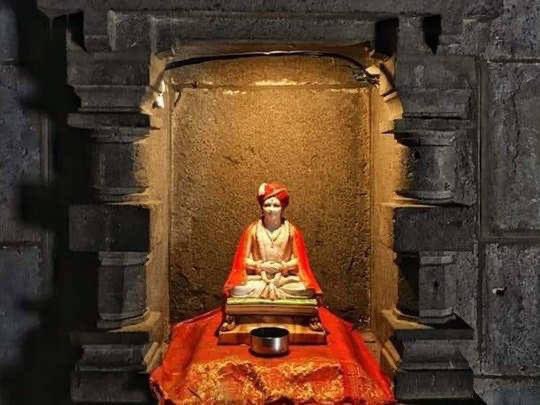
Some thoughts on the two particular episodes of Jñānèshvara Maharaj’s life :
1. Brahmins refusing upanayana to children of a sannyāsi
2. Some opposition to principle of translating gītā and knowledge of upanishads out of Sanskrit into Marathi (or any other regional language)
1. Brahmins refusing upanayana to children of a sannyāsi
2. Some opposition to principle of translating gītā and knowledge of upanishads out of Sanskrit into Marathi (or any other regional language)
https://twitter.com/kal_chiron/status/1337962221167542272
Episode 1 : Refusal acceptance in society of kids born to a sannyāsi :
Vitthalpant Kulkarni was a person born in a deshastha Brahmin family. Got married. But after marriage (and before having kids), he thought he found a higher calling and developed vairāgya.
Vitthalpant Kulkarni was a person born in a deshastha Brahmin family. Got married. But after marriage (and before having kids), he thought he found a higher calling and developed vairāgya.
I have made a thread on “what it means to take a sannyāsa”. You may find it below.
Vitthalapant Kulkarni left his home, his parents, his wife and his right on any property (he was eldest son and as per mitākshara system of Hindu inheritance- sole kartā of the property).
Vitthalapant Kulkarni left his home, his parents, his wife and his right on any property (he was eldest son and as per mitākshara system of Hindu inheritance- sole kartā of the property).
https://twitter.com/kal_chiron/status/1211180275113185280
Upon taking sannyāsa (as described in thread above), one performs one’s own symbolic antim-sanskāra- thereby burning away any associations one has with past life (the way it happens when we actually die)
A sannyāsa dīkshā is a very serious undertaking. Not to be taken lightly.
A sannyāsa dīkshā is a very serious undertaking. Not to be taken lightly.
After few years of living as a sannyāsi, guru of “erstwhile” Vitthal Kulkarni realised that he has begun pining for his wife, his old life and his old identity.
The vairāgya he thought he had was not the real one. It was perhaps a phase in life. Perhaps some divine plan.
The vairāgya he thought he had was not the real one. It was perhaps a phase in life. Perhaps some divine plan.
Always Remember :
1. A routine Brahmin from gurukulas, pathshala, purohit and knower of dharmashastras is not always a brahmagnāni.
2. It is his job to ensure society follows the norms of dharma.
3. A Brahmin is not “All-Knowing”. He takes decisions/rulings circumstantially
1. A routine Brahmin from gurukulas, pathshala, purohit and knower of dharmashastras is not always a brahmagnāni.
2. It is his job to ensure society follows the norms of dharma.
3. A Brahmin is not “All-Knowing”. He takes decisions/rulings circumstantially
A person leaving everything and every right on life wife and property - suddenly returning (to claim it all back) is serious legal as well as dhārmik issue.
People will start taking vows of marriage and sannyasa dharma casually. Bad precedence.
People will start taking vows of marriage and sannyasa dharma casually. Bad precedence.
Vitthalpant on the other hand did not want anything else. All he wanted for his children to be performed upanayana upon.
The prāyaschitta given by the pandits was extraordinarily harsh. Asking parents to die so that their children will be accepted was indeed cold hearted.
The prāyaschitta given by the pandits was extraordinarily harsh. Asking parents to die so that their children will be accepted was indeed cold hearted.
But given the above context, there is some reasoning behind this.
Secondly, in that period : a monastic sect called mahānubhav sampradāya was quite popular among MH-Hindus (all were Hindus). It was kind of like Buddhism, at clash with varNāshrama dharma
Secondly, in that period : a monastic sect called mahānubhav sampradāya was quite popular among MH-Hindus (all were Hindus). It was kind of like Buddhism, at clash with varNāshrama dharma
Lot of people left everything- seriously affecting balance of grihastha society. If too many become sannyaasis, who will be teacher, soldier merchant, service-provider?
All this happening with Gaznavid and Ghurid invasions beginning in North.
All this happening with Gaznavid and Ghurid invasions beginning in North.
No one at that time knew that vitthalpant Kulkarni is going to father Jñānèshvara when he returned from sannyāsa and started “living-in” with his wife of purvāshrama.
All this needs to be taken into context while forming an opinion here.
All this needs to be taken into context while forming an opinion here.
Hindu dharma had to negotiate very tricky problems in last 1000 years.
Same applies to translating vedāntik knowledge in local languages -
Same problem with what we have in translating same knowledge in English - what to do with “non-translatables?” - as @RajivMessage puts it
Same applies to translating vedāntik knowledge in local languages -
Same problem with what we have in translating same knowledge in English - what to do with “non-translatables?” - as @RajivMessage puts it
Jñānèshvara essentially gave same solution as we do today - use the original Sanskrit words as it is in Marathi.
Jñānèshvara did not try to translate kaivalya in Marathi. Or murti. Or deva. He just used them in Marathi as it is.
Jñānèshvara did not try to translate kaivalya in Marathi. Or murti. Or deva. He just used them in Marathi as it is.
Jñānèshvara Sanskritised the contemporary Marathi language to such an extent in this way that today’s Marathi is almost 90-95% Sanskrit words.
I cannot even understand the 900 year old Marathi used by Chakradhar Swami of Mahanubhav sampraday)
But I can easily understand 800 year old Marathi of Jñānèshvara.
We essentially are having same problem today with English. 😊
But I can easily understand 800 year old Marathi of Jñānèshvara.
We essentially are having same problem today with English. 😊
• • •
Missing some Tweet in this thread? You can try to
force a refresh






